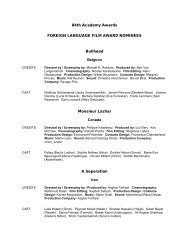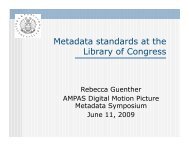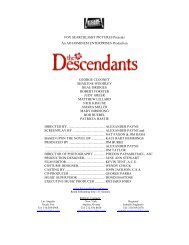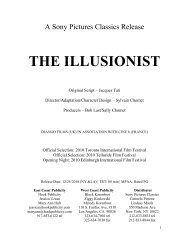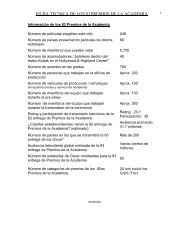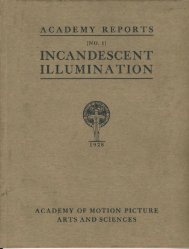FOX SEARCHLIGHT PICTURES Presents In association with ...
FOX SEARCHLIGHT PICTURES Presents In association with ...
FOX SEARCHLIGHT PICTURES Presents In association with ...
Create successful ePaper yourself
Turn your PDF publications into a flip-book with our unique Google optimized e-Paper software.
“Very soon after I first started thinking of the idea for BLACK SWAN, I met <strong>with</strong> Natalie for coffee in Times<br />
Square,” he recalls. “She had done a lot of ballet before she became an actress and had continued doing it over<br />
the years just to stay in shape. She told me straight away that one of the things she’d always wanted to do was<br />
play a dancer.”<br />
Though it would take almost ten years after their meeting before the BLACK SWAN screenplay was<br />
finished, when Portman read it, she was riveted by Nina’s twisting psychological journey.<br />
Nina starts out as what the ballet world calls a “bunhead,” a not-so-endearing term for a ballerina so<br />
devoted to dance that nothing else matters, who is sheltered by her equally driven, former-dancer mother and<br />
who never really developed an adult life of her own. But when she gets the role of the Swan Queen, it awakens<br />
something new in her, a need to explore her deepest, darkest feelings which begin to unhinge the fragile edges<br />
of her mind. Nina, like the Swan Queen she wants to embody, suddenly becomes embroiled in a story of<br />
enchantment, desire and danger.<br />
This pushed Portman to edges that she had never before explored on screen – and required her to peer<br />
into the abyss. “Nina is dedicated, hardworking but also obsessive,” the actress explains. “She doesn’t yet have<br />
her own voice as a dancer, as a young woman, but she progressively changes as she searches to find her<br />
sensuality and sense of freedom. At the same time, she also starts to come undone, and that was the challenge. “<br />
She continues: “What Nina wants is perfection, which is something that can only exist for a moment, a<br />
brief, fleeting moment -- but like all artists, she may have to destroy herself to find that. When she tries to<br />
become the Black Swan, something dark starts to bubble inside her. It becomes an identity crisis where she’s<br />
not only unsure of who she is but the lines become blurred between her and other people. She starts literally<br />
seeing herself everywhere.”<br />
Trapped in this dizzying world of doubles and deceptive appearances, of mysterious encounters and<br />
erupting wounds, Nina begins to lose control -- and Portman had to do so, also.<br />
“As Nina begins to rebel against all the structures around her,” she notes, “it comes <strong>with</strong> all this<br />
paranoia that takes her to a dark place, where she isn’t sure what other people want from her and whether or not<br />
she’s losing her mind.”<br />
Amidst the darkness, Portman was thrilled to have a chance to immerse herself in the ballet world she,<br />
like Nina, dreamed about as a young girl. “I loved the authenticity of all these very real dance world details in<br />
the screenplay,” she says, “and I especially loved how Nina’s story parallels ‘Swan Lake.’ I saw her as<br />
someone really trying to break free of a spell – trying to break free of everyone else defining who she is and<br />
trying to see through all of it who she really is as a person and an artist.”<br />
And yet, as Nina begins to lose the thread of reality, she cannot let anyone know what she’s going<br />
through, lest she lose the role of the Swan Queen to her most threatening rival, the sensuous, shameless Lily --<br />
who becomes Nina’s alternate, both literally and figuratively.<br />
5





